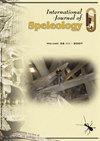Bacteria, guano and soot: Source assessment of organic matter preserved in black laminae in stalagmites from caves of the Sierra de Atapuerca (N Spain)
IF 1.3
4区 地球科学
Q3 GEOSCIENCES, MULTIDISCIPLINARY
引用次数: 6
Abstract
Speleothems are a recognized source of paleoclimatic information, but their value as a source of signals from human activities in caves with an archaeological record has rarely been explored. Previous studies of speleothems in the Sierra de Atapuerca karst system (Burgos, northern Spain) revealed an important human fossil record, provided information about human activities in and around these caves, and the impacts on their natural environment. The present study reports the results of molecular characterization of dark-colored laminae from the stalagmites Ilargi (Galería de las Estatuas) and GS1, GS2, and GS3 (Galería del Silo), by pyrolysis-GC-MS (Py-GC-MS) and thermally assisted hydrolysis and methylation (THM-GC-MS). The features of the organic matter demonstrate the presence of (1) a dominant aliphatic fraction probably from in situ bacterial and ex situ plant-derived lipids, (2) black carbon (from soot and/or charcoal), (3) polysaccharides and N-rich moieties (probably from bat guano and microbial sources), and (4) a signal of terpenoid derivatives that may originate from the overlying limestone (kerogen) and extant gymnosperm resin (soils) or cyanobacteria (cave). Some plant-derived lignin may be present as well but was not identified unambiguously. It is concluded that this approach allows identifying multiple general sources of organic matter which can help understand speleothem formation processes, and evidence of soot deposition could be clearly linked to human activities.细菌、鸟粪和煤烟:阿塔普尔卡山脉洞穴石笋中黑色薄层中保存的有机物来源评估(西班牙北部)
Speleothem是公认的古气候信息来源,但它们作为有考古记录的洞穴中人类活动信号来源的价值很少被探索。先前对Sierra de Atapuerca岩溶系统(西班牙北部布尔戈斯)洞穴主题的研究揭示了一个重要的人类化石记录,提供了有关这些洞穴内和周围人类活动的信息,以及对其自然环境的影响。本研究报道了石笋Ilargi(Galería de las Estatuas)和GS1、GS2和GS3(Galerèa del Silo)的深色薄片的分子表征结果,通过热解GC MS(Py-GC-MS)和热辅助水解和甲基化(THM-GC-MS)。有机物的特征表明存在(1)可能来自原位细菌和非原位植物衍生脂质的主要脂族部分,(2)炭黑(来自烟灰和/或木炭),(3)多糖和富氮部分(可能来自蝙蝠粪和微生物来源),和(4)萜类衍生物的信号,其可能来源于上覆的石灰岩(干酪根)和现存的裸子植物树脂(土壤)或蓝藻(洞穴)。一些植物衍生的木质素也可能存在,但尚未明确鉴定。结论是,这种方法可以识别有机物的多种一般来源,这有助于了解洞穴洞穴的形成过程,烟灰沉积的证据可能与人类活动明确相关。
本文章由计算机程序翻译,如有差异,请以英文原文为准。
求助全文
约1分钟内获得全文
求助全文
来源期刊

International Journal of Speleology
地学-地球科学综合
CiteScore
3.10
自引率
23.10%
发文量
12
审稿时长
>12 weeks
期刊介绍:
The International Journal of Speleology has the aim to get cave and karst science known to an increasing number of scientists and scholars. The journal therefore offers the opportunity to all scientists working in and on karst to publish their original research articles or their review papers in an open access, high quality peer reviewed scientific journal at no cost. The journal offers the authors online first, open access, a free PDF of their article, and a wide range of abstracting and indexing services.
 求助内容:
求助内容: 应助结果提醒方式:
应助结果提醒方式:


